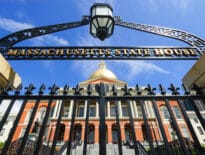
Fed Chair Jerome Powell speaks at a press conference on Feb. 1, 2023 following a meeting of the central bank's interest rate-setting committee. Federal Reserve photo
The Federal Reserve reinforced its fight against high inflation Wednesday by raising its key interest rate by a quarter-point to the highest level in 16 years. But the Fed also signaled that it may now pause the streak of 10 rate hikes that have made borrowing for consumers and businesses steadily more expensive.
In a statement after its latest policy meeting, the Fed said that while the banking system is “sound and resilient,” the upheaval in the financial system could slow borrowing, spending and growth. It reiterated that the impact of pullback in bank lending “remains uncertain.”
The Fed’s rate increases over the past 14 months have more than doubled mortgage rates, elevated the costs of auto loans, credit card borrowing and business loans and heightened the risk of a recession. Home sales have plunged as a result. The Fed’s latest move, which raised its benchmark rate to roughly 5.1 percent, could further increase borrowing costs.
Yet the Fed’s efforts have only partly succeeded in taming the worst inflation bout in four decades, and the surge in rates has contributed to the collapse of three large banks and turmoil in the banking industry. All three failed banks had bought long-term bonds that paid low rates and then rapidly lost value as the Fed sent rates higher.
The banking upheaval might have played a role in the Fed’s decision Wednesday to consider a pause. Chair Jerome Powell had said in March that a cutback in lending by banks, to shore up their finances, could act as the equivalent of a quarter-point rate hike in slowing the economy.
Fed economists have estimated that tighter credit resulting from the bank failures will contribute to a “mild recession” later this year, thereby raising the pressure on the central bank to suspend its rate hikes.
The Fed is now also grappling with the threat of a prolonged standoff around the nation’s borrowing limit, which caps how much debt the government can issue. Congressional Republicans are demanding steep spending cuts as the price of agreeing to lift the nation’s borrowing cap.
Lawrence Yun, chief economist at the National Association of Realtors, criticized the Fed’s move, citing data that showed year-over-year inflation has cooled substantially.
“The latest interest rate hike by the Federal Reserve is unnecessary and harmful. Consumer price inflation has been decelerating and will continue this trend. After the awful 9% consumer price inflation in the summer of last year, the latest data shows 5% inflation. It will be even lower as the heavyweight component to inflation, which is housing rent, will inevitably slow down given the 40-year high robust construction of new empty apartment units,” Yun said. “In addition, there is significant additional monetary policy tightening already occurring. The fast rate hikes by the Fed have upended the balance sheets of many small regional banks. They are becoming zombie-like banks, unable to lend even to good businesses as they are more concerned with balance sheet shuffling for survival. This situation will worsen with each additional rate hike by the Federal Reserve. Only by stopping the rate hikes or even a reversal later in the year after verifying much calmer inflation rates will the small banks have a better chance of survival against the big banks.”






